While great passing skills and ball control are valuable traits for a point guard and quarterback to have, the best trait they could probably have is the ability to influence other players in the right way and make them — and the team as a whole — better.
Whether we realize it or not, a deep part of our social psyche is the tendency for others to influence our behavior — for the better or for the worst. As such, there is some truth to the saying: who you surround yourself with is who you’ll become.
After this chapter overview, you’ll be equipped with the basic knowledge on how the presence of others can influence behavior, both from an individual and group perspective. Let’s go!
Social Processes and Behavior on the MCAT: What You Need to Know
Topics on sensation and perception will be tested on the Psych/Soc section of the MCAT and can appear both as passage based and fundamental discrete questions.
We’ve calculated that about 3-5 questions covering social processes and behavior can possibly come up on the MCAT!
Introductory psychology accounts for 65% of the content covered in the Psychological, Social, and Biological Foundations of Behavior while introductory sociology covers about 30 of the content.
Important Sub-Topics: Social Processes and Behavior
While this chapter definitely covers aspects of social psychology similar to our “Social Thinking and Attitude” and “Social Interactions” chapter overview, social processes and behavior highlight more about how the presence of others affects our behavior!
Contrast this to our other chapter overview on “Social Thinking and Attitude”, which was much more focused on understanding behaviors that we’re a bit more inherent within our social psyche.
1. The Effects of Others on Individual Behavior
As mentioned in the title above, we’ll first look at how the presence of others can affect the behavior of an individual. Whether it’s getting nervous to shoot a free throw against an opposing team or wanting to take off your shirt in public because your friends are doing it, these are all great examples of this phenomenon!
Let’s first take a look at a possible benefit the presence of others can have, as seen in social facilitation. This is the phenomenon where the presence of others will improve your ability to perform a task! Interestingly, aspects of motivation — specifically, arousal theory — can explain why this is the case.
The task may be fairly easy and may not stimulate the optimal arousal level in the individual. The addition of others can be enough to stimulate arousal to an appropriate level to achieve the highest performance of a task!
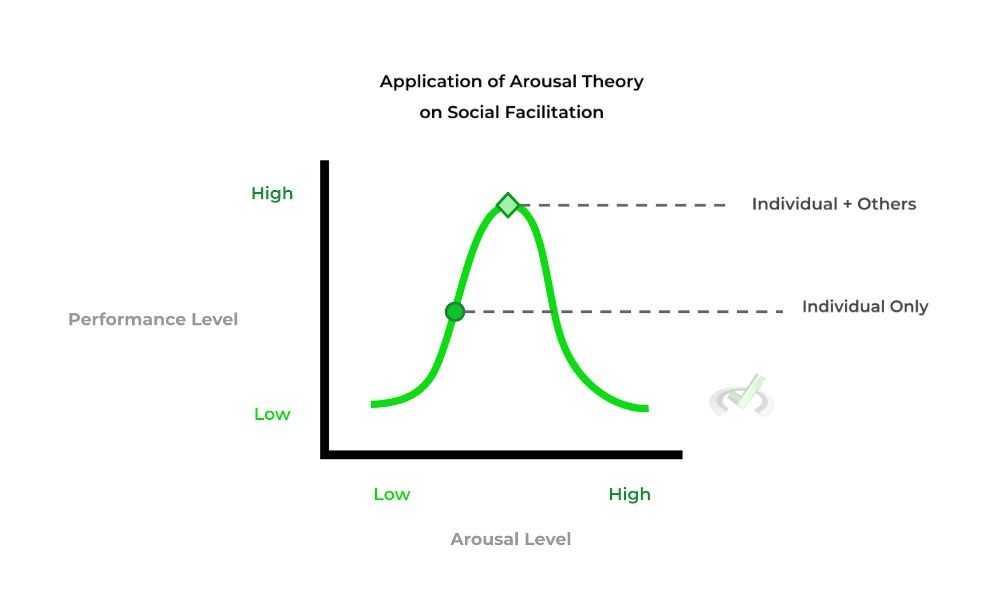
Let’s dive into this concept more with an example: say Michael Jordan is just shooting free throws by himself at the gym. Being that he’s the GOAT (debatable!!), those free throws would most likely seem boring to him and he probably won’t try as hard, maybe only knocking 8 for 10.
Now, put him again at the free throw line, except now, there are thousands of fans screaming his name at the arena. According to social facilitation and arousal theory, those screaming fans are probably not gonna phase him and his performance will actually improve, knocking down a perfect 10 for 10.
However, on the opposite spectrum of social facilitation is social loafing, where the presence of others in a collective group task results in a decrease in one’s ability to perform a task, such as when taking part in a group project and noticing that one member is noticeably putting less effort.
One explanation for this occurrence is the diffusion of responsibility: as the number of group members increases, deindividuation may occur where the individual believes their role and effort won’t be of much value and as a result begin putting less effort.

Another important social phenomenon that a lot of YouTube shorts want to test out is the bystander effect, which is the tendency of an individual to resist helping another individual in distress in a public setting.
Generally speaking, the greater the number of people, the greater the bystander effect (i.e. the more likely an individual won’t be willing to help the distressed individual). There are a couple of reasons to explain this including the diffusion of responsibility and group cohesiveness.
As shown in the figure below, an increased number of people results in an increase in the diffusion of responsibility; similar to social loafing, the individual has a lower motivation to help the distressed individual because that responsibility is now equally distributed among the larger number of people.
Additionally, another factor that may contribute to the bystander effect is group cohesiveness, or in other words how well the group of people is familiar with one another.
As one would probably expect, if the group is formed by individuals who are familiar and know each other, the bystander effect would be mitigated. Conversely, if the group is made up of strangers, the bystander effect would be enhanced.
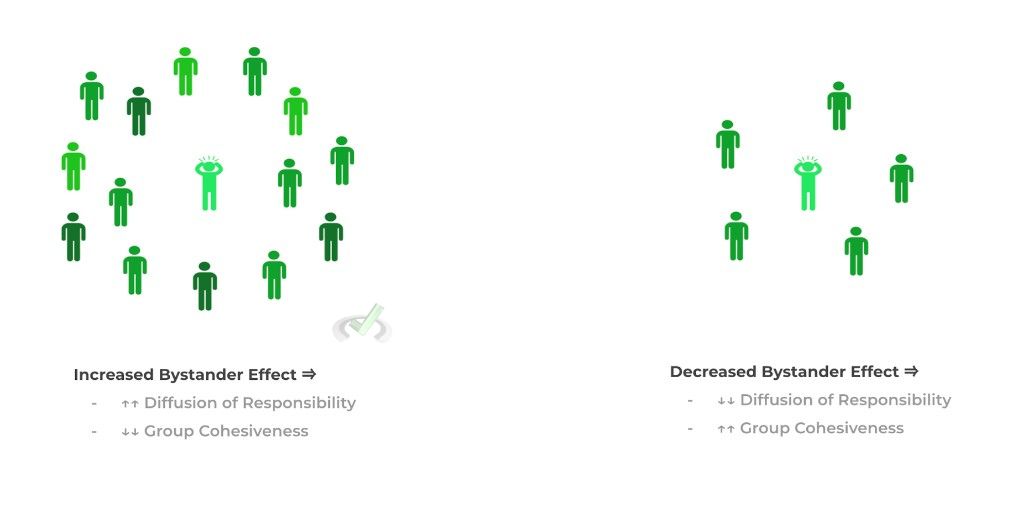
Finally, we’ll discuss the differences between the social phenomena of obedience, conformity, and compliance, as all these social phenomena involve an individual’s behavior yielding to the request or influence of others’ behavior.
The 3 terms primarily differ in the degree to which others exert their influence on an individual to sway their behavior. Conformity has the least (if not, no) coercion in influencing an individual’s behavior: the individual simply adopts the common behavior of others in order to conform and prevent being an outcast.
Compliance goes a step further, where an individual engages in behavior at the request of others. At the most extreme end is obedience, where an individual adopts a behavior at the order of others, oftentimes an authoritative figure.
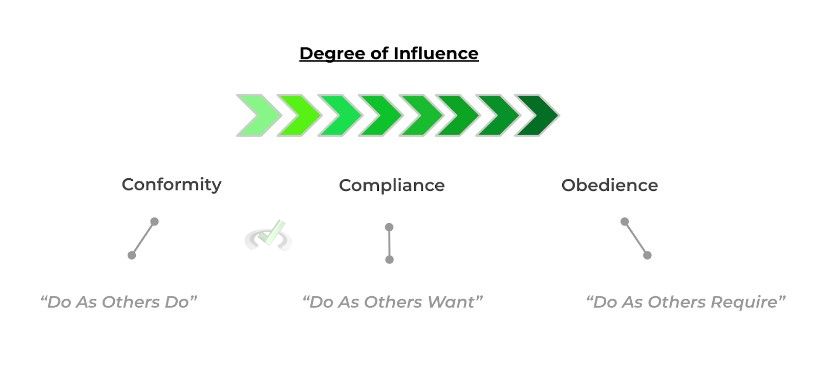
We can use the case study of peer pressure to explain the difference between conformity and compliance. Usually peaking in adolescence, peer pressure refers to either the direct or indirect influence peers can have on an individual’s behavior.
Whether or not individuals engage in conformity or compliance in response to peer pressure depends on whether it’s direct or indirect: individuals may simply conform to the behaviors of their peers for fear of being excluded.
However, an individual engaging in a behavior per the direct request or want of peers represents compliance by the individual. Again, the main difference is whether peer pressure is direct or indirect.
Full Study Notes : The Effects of Others on Individual Behavior
For more in-depth content review on how individuals’ behavior is affected by others, check out these detailed lesson notes created by top MCAT scorers.
2. The Effects of Others on Group Psychology
As opposed to the first section which focused on how others could influence individuals’ behavior, this section focuses on how others can affect the behavior of a group as a whole. Here, we’ll focus on 2 main group social phenomena: group polarization and groupthink.
Group polarization refers to the social phenomenon where the ideas and/or decisions of a group of like minded individuals become more extreme after a group discussion. In other words, the initial opinion/idea is a bit milder; however, after discussion with individuals who have a similar viewpoint, that initial opinion becomes intensified!

Take the example above: suppose there’s a group of basketball fans who are really fond of Paul Pierce. By themselves, before group discussion, the fans think that Pierce is a great basketball player but certainly not in the discussion for top 10 of all time.
After talking with each other about how great Paul Pierce is, his greatness starts to become overly emphasized to the point where now the fans believe that he’s the GOAT of basketball ahead of Michael Jordan and Lebron James! (If you’re an NBA fan — well, you know……)
The other phenomenon we’ll discuss is groupthink, which is the tendency for individuals in a group to come to an agreement on a decision in a way where outside opinions and viewpoints from others are deemphasized.
It can also be thought of as another example of conformity: after an initial opinion or idea is proposed, individuals with opposing viewpoints tend not to voice their opinions in an effort to conform and support the harmony within the group — however, this can lead to bad decisions being made and foster a lack of creativity!

There are a few ways and strategies which can mitigate groupthink: for one, it helps not to have a direct leader. While it’s always great to have a leader, sometimes it can lead to having an authoritative figure and discourage others from voicing their opinions when it contradicts the leader’s.
Another way to mitigate the effect of groupthink is to encourage more open discussion and motivate each individual member to voice their own opinion!
Full Study Notes : The Effects of Others on Group Psychology
For more in-depth content review on the effects of others on group psychology, check out these detailed lesson notes created by top MCAT scorers.
3. Normative Behavior Established By Socialization
Finally, let’s get introduced to some basic social norms and how those social norms become established in society. Simply put, social norms refer to behaviors that are seen as acceptable and followed by society — note, however, that social norms can also differ depending on the circumstances and cultures!
People oftentimes abide by social norms in order to maintain the status quo and not be viewed as an outsider. Additionally, it can also be viewed in the sense that they want to conform, comply, and obey the social norms established.
In general, there are 4 main types of social norms: folkways, mores, taboos, and laws. Furthermore, these social norms can be enforced via what are called sanctions, which can be formal or informal. Take a look at the figure below:
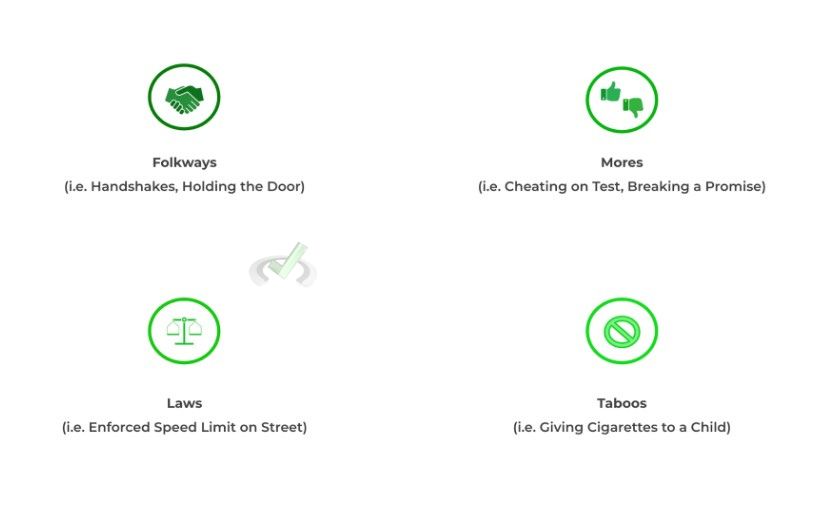
Folkways refer to common everyday social gestures that everyone participates in such as holding the door for someone or saying, “excuse me”. Mores are a step up from folkways as they also refer to agreed upon behavior; however, mores have a greater sense of morality associated with them.
Additionally, the violation of mores is viewed much more negatively than compared to folkways: not holding the door for someone will for sure make eyes turn but cheating on the MCAT will for sure be viewed with much greater negative connotation!
Think of taboos as “absolute no’s” when it comes to behaviors in society and are viewed with the most negative connotation by society. Laws are directives meant to be followed by an authoritative figure/institution, such as the government.
Social norms are reinforced by either formal or informal sanctions, which is a fancy way of saying the consequences of either obeying or breaking a social norm. Formal sanctions are similar to laws as they are consequences issued by law as well, while informal sanctions consequences are not set in stone, but are generally agreed upon.
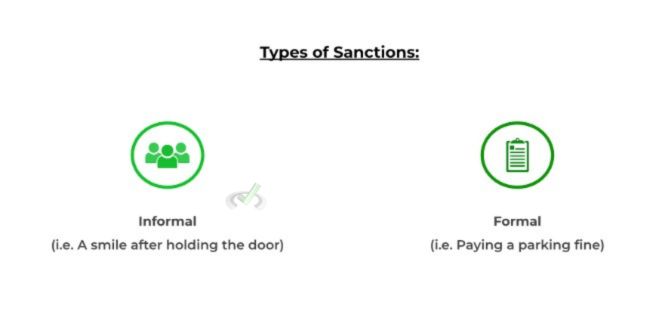
Full Study Notes : Normative Behavior Established by Socialization
For more in-depth content review on normative behavior established by socialization, check out these detailed lesson notes created by top MCAT scorers.
Important Definitions and Key Terms
Below are some high yield definitions and key terms to refer to when reviewing concepts and ideas about social processes and behavior!
Term | Definition |
|---|---|
Social Facilitation | The idea that an individual’s performance of a task increases and improves in the presence of others |
Social Loafing | Observation that individuals will tend to decrease their effort when placed in a group tasks with other individuals |
Diffusion of Responsibility | One possible explanation for why social loafing and the bystander effect occur, as the increase number of individual redistributes the responsibility for a given task |
Bystander Effect | Social phenomenon where individuals in a public setting tend not to help a distressed individual |
Conformity | Occurs when an individual changes their behavior in an effort to conform and prevent being an outcast |
Compliance | Occurs when an individual changes their behavior in order to comply with a request of another |
Obedience | Occurs when an individual changes their behavior in order to obey with the demand of another |
Group Polarization | Group phenomenon where an individual’s milder opinion or take becomes more extreme after group discussion with other likeminded individuals |
Groupthink | Group phenomenon where individuals tend to not voice opposing opinions in order to maintain the peace within a group |
Social Norms | Refers to behaviors that are widely accepted by society |
Folkways | Social norms that involve common daily gestures that everyone generally participates in |
Mores | Social norms that carry an important emphasis on morality |
Taboos | Extreme negative social norms which a subjected to extreme negative condemnation when performed |
Laws | Formal request for obedience usually given by an authoritative figure/institution |
Sanctions | Refers to the consequences that result from the obedience or breaking of social norms; Can be divided into formal or informal sanctions |
Additional FAQs - Social Processes and Behavior on the MCAT
A. Is Social Psychology on the MCAT?
B. How Does the Presence of Others Affect Individual Behavior – MCAT?
C. What is the Hawthorne Effect – MCAT?
D. What is Social Loafing – MCAT?
One explanation for this is that there is a diffusion of responsibility where individuals believe they don’t have to put in as much effort because the responsibility to complete that project is distributed.







 To help you achieve your goal MCAT score, we take turns hosting these
To help you achieve your goal MCAT score, we take turns hosting these 





















 reviews on TrustPilot
reviews on TrustPilot